Abstract
The relationship of the dose of vaccine to the immune response was determined in CF-1 mice vaccinated intraperitoneally with viable cells of the attenuated H37Ra strain of Mycobacterium tuberculosis and in mice vaccinated with cells of the same strain killed by autoclaving at 121 C for 15 min. The results showed, in terms of increased resistance to tuberculous infection, that the immune response with both living and killed cells was dependent upon the dose of vaccine, whereas only the living cells were dependent upon the time of challenge after vaccination. The dose response curves show dramatically that viable cells, which do not multiply in vivo, are several hundred times more effective immunizing agents against tuberculous infection than are autoclaved cells. Viable 2-week-old H37Ra cells were far more immunogenic than viable 4-week-old cells. Autoclaved 2-week-old cells, however, were no more immunogenic than autoclaved 4-week-old cells. H37Ra cells killed by boiling (98 C), exposure to 65 C for 30 min, treating with 2% phenol, or by being dried with acetone also lost most of their capacity to immunize mice. The effect of adjuvant on the immune response of mice to tuberculous infection was tested by incorporating both viable and autoclaved cells in Freund's incomplete adjuvant. We found that this vehicle had little or no effect on the immunizing capacity of either viable or heat-killed mycobacterial cells. The relationship of all the findings to the specificity of the immune response to tuberculosis is discussed.
Full text
PDF
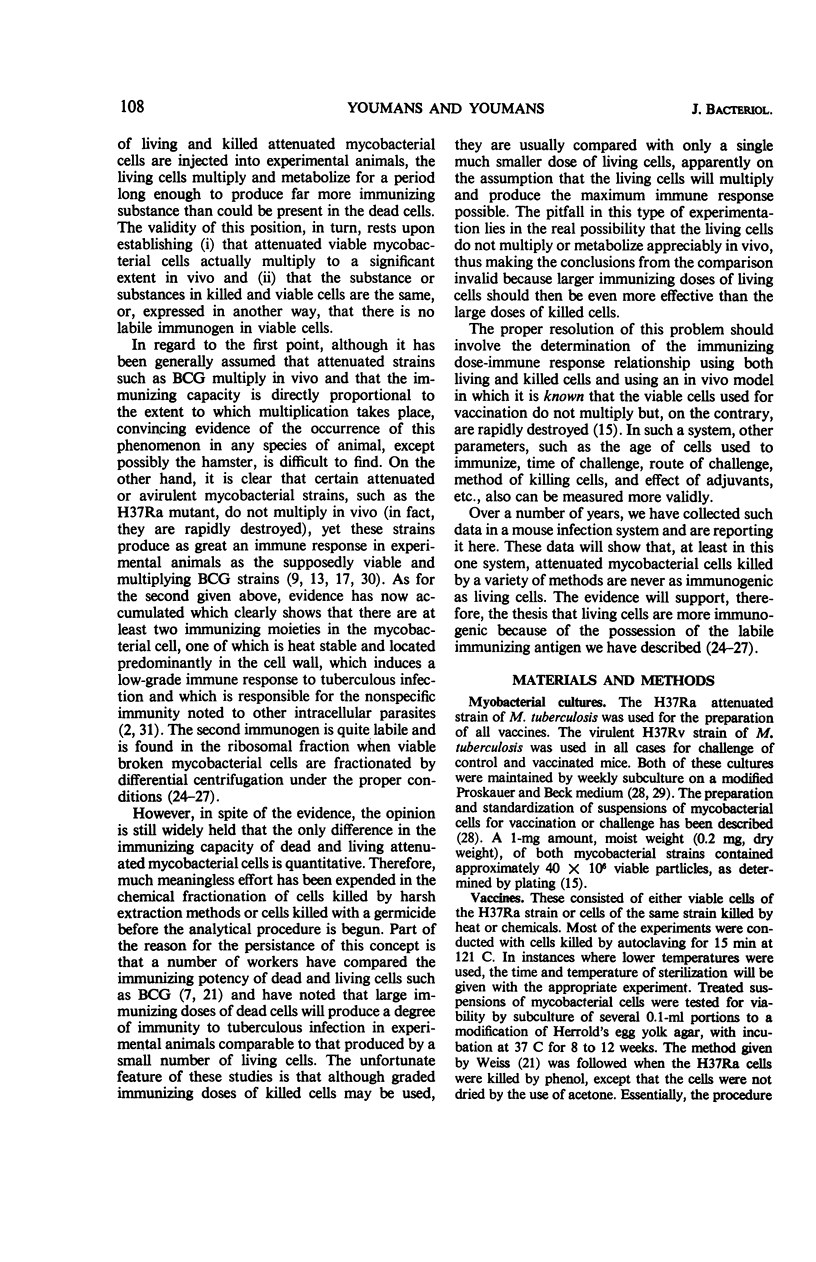

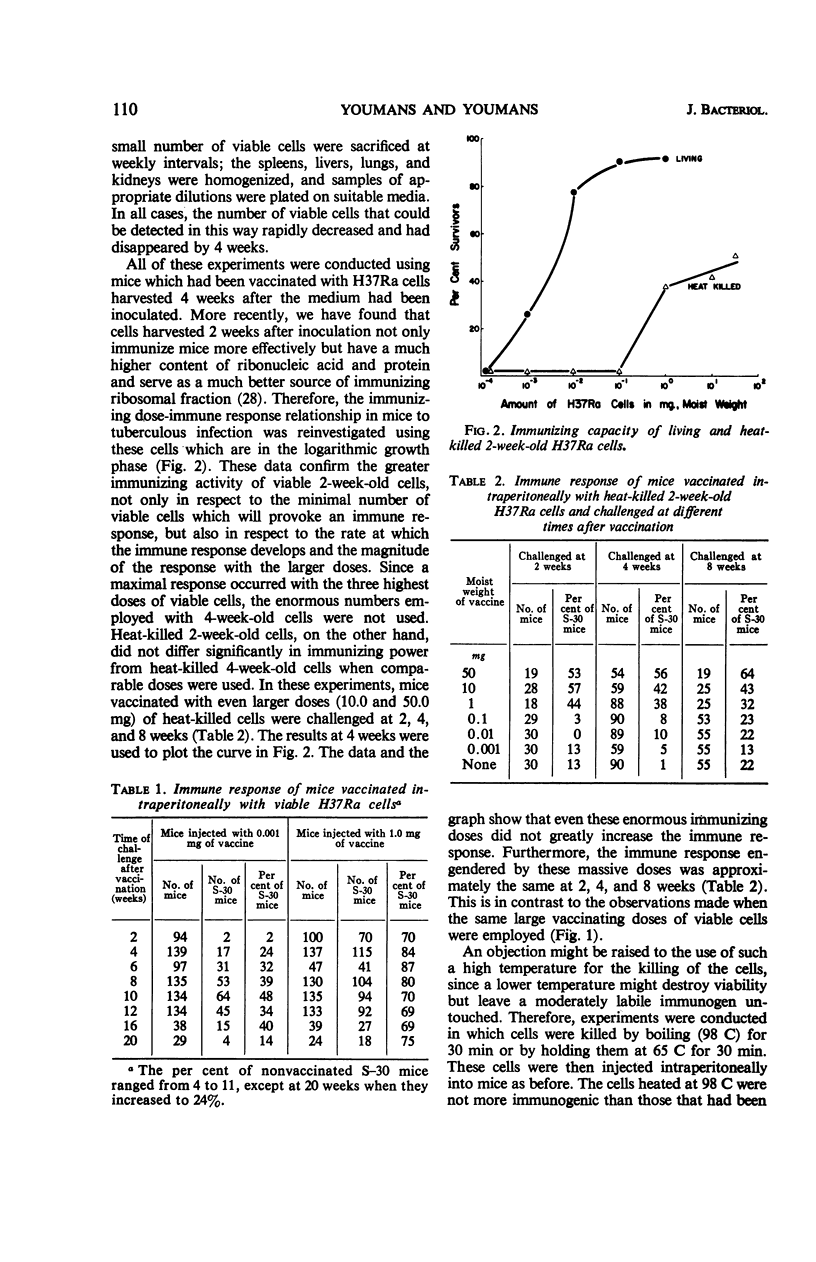
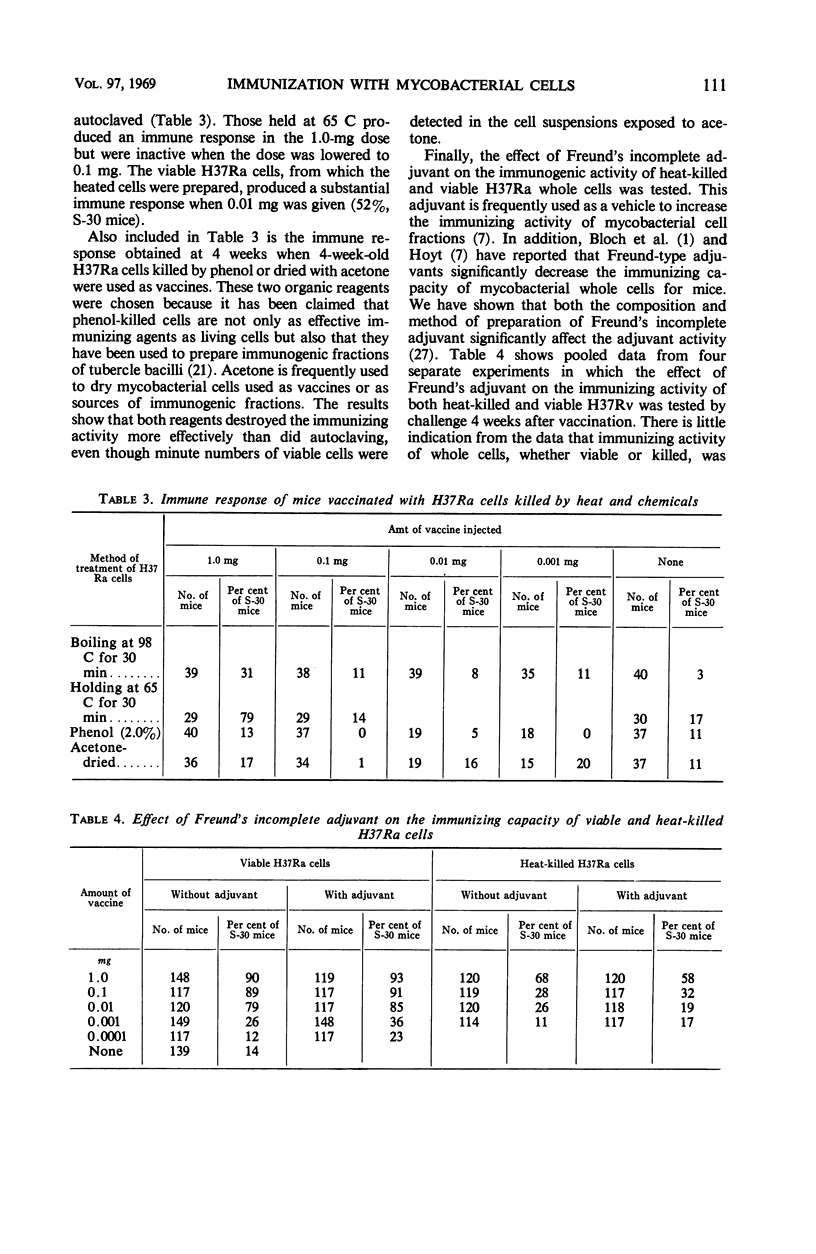
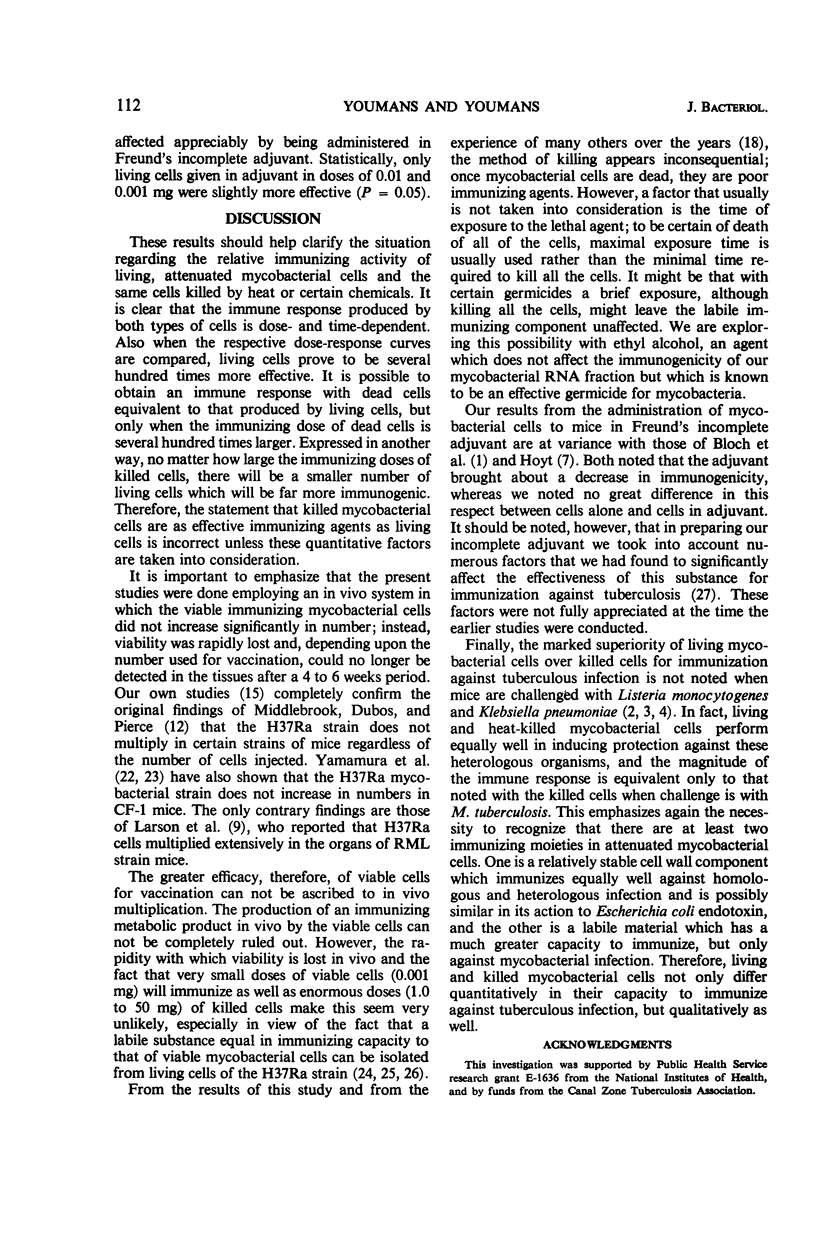
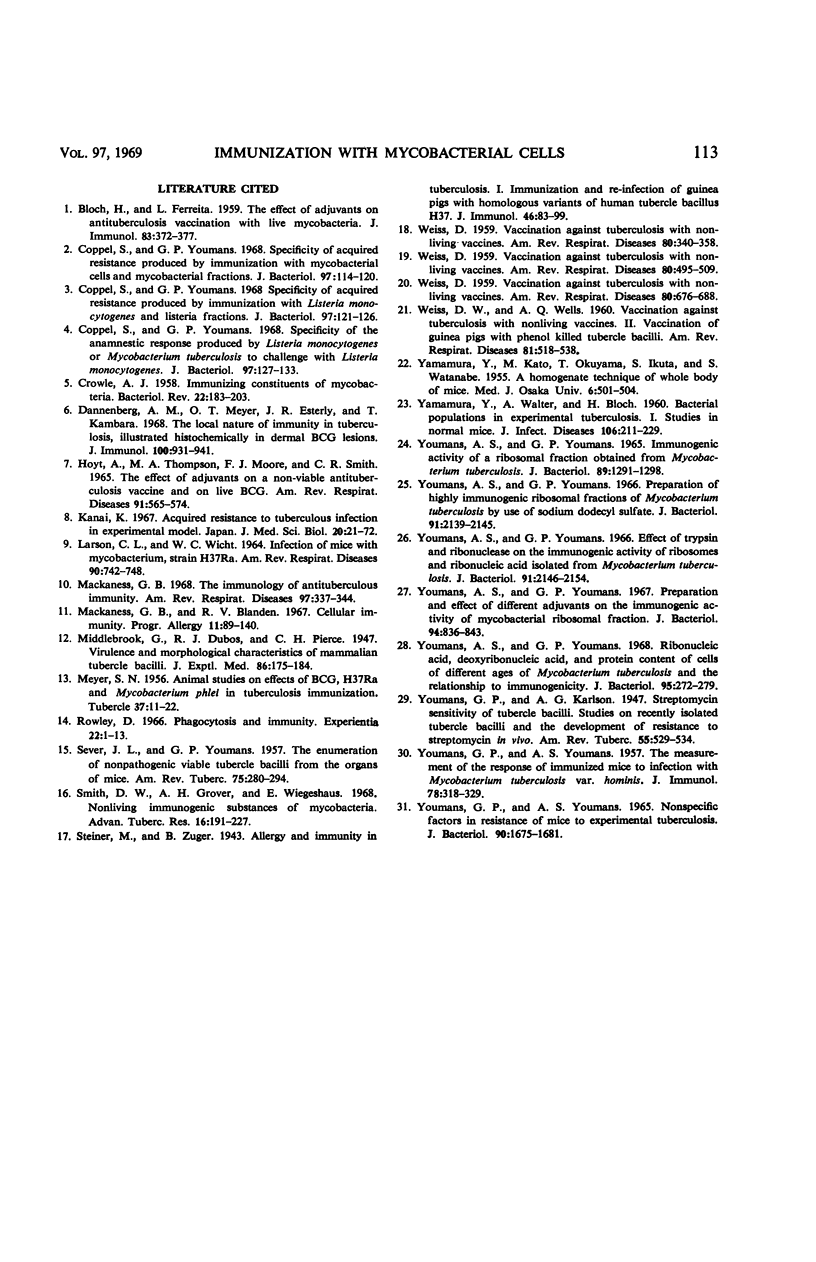
Selected References
These references are in PubMed. This may not be the complete list of references from this article.
- BLOCH H., FERREIRA I. The effect of adjuvants on antituberculosis vaccination with live Mycobacteria. J Immunol. 1959 Oct;83:372–377. [PubMed] [Google Scholar]
- BLOCH H., YAMAMURA Y., WALTER A. Bacterial populations in experimental murine tuberculosis. II. Studies in vaccinated mice. J Infect Dis. 1960 Mar-Apr;106:223–229. doi: 10.1093/infdis/106.2.223. [DOI] [PubMed] [Google Scholar]
- CROWLE A. J. Immunizing constituents of the tubercle bacillus. Bacteriol Rev. 1958 Sep;22(3):183–203. doi: 10.1128/br.22.3.183-203.1958. [DOI] [PMC free article] [PubMed] [Google Scholar]
- Coppel S., Youmans G. P. Specificity of Acquired Resistance Produced by Immunization with Listeria monocytogenes and Listeria Fractions. J Bacteriol. 1969 Jan;97(1):121–126. doi: 10.1128/jb.97.1.121-126.1969. [DOI] [PMC free article] [PubMed] [Google Scholar]
- Coppel S., Youmans G. P. Specificity of acquired resistance produced by immunization with mycobacterial cells and mycobacterial fractions. J Bacteriol. 1969 Jan;97(1):114–120. doi: 10.1128/jb.97.1.114-120.1969. [DOI] [PMC free article] [PubMed] [Google Scholar]
- Coppel S., Youmans G. P. Specificity of the anamnestic response produced by Listeria monocytogenes or Mycobacterium tuberculosis to challenge with Listeria monocytogenes. J Bacteriol. 1969 Jan;97(1):127–133. doi: 10.1128/jb.97.1.127-133.1969. [DOI] [PMC free article] [PubMed] [Google Scholar]
- Dannenberg A. M., Jr, Meyer O. T., Esterly J. R., Kambara T. The local nature of immunity in tuberculosis, illustrated histochemically in dermal BCG lesions. J Immunol. 1968 May;100(5):931–941. [PubMed] [Google Scholar]
- HOYT A., THOMPSON M. A., MOORE F. J., SMITH C. R. THE EFFECT OF ADJUVANTS ON A NONVIABLE ANTITUBERCULOSIS VACCINE AND ON LIVE BCG. Am Rev Respir Dis. 1965 Apr;91:565–574. doi: 10.1164/arrd.1965.91.4.565. [DOI] [PubMed] [Google Scholar]
- Kanai K. Acquired resistance to tuberculous infection in experimental model. Jpn J Med Sci Biol. 1967 Feb;20(1):21–72. doi: 10.7883/yoken1952.20.21. [DOI] [PubMed] [Google Scholar]
- LARSON C. L., WICHT W. C. INFECTION OF MICE WITH MYCOBACTERIUM TUBERCULOSIS, STRAIN H37RA. Am Rev Respir Dis. 1964 Nov;90:742–748. doi: 10.1164/arrd.1964.90.5.742. [DOI] [PubMed] [Google Scholar]
- MEYER S. N. Animal studies on effects of BCG, H37Ra and Mycobacterium phlei in tuberculosis immunization. Tubercle. 1956 Jan-Feb;37(1):11–22. doi: 10.1016/s0041-3879(56)80092-5. [DOI] [PubMed] [Google Scholar]
- Mackaness G. B., Blanden R. V. Cellular immunity. Prog Allergy. 1967;11:89–140. [PubMed] [Google Scholar]
- Mackaness G. B. The immunology of antituberculous immunity. Am Rev Respir Dis. 1968 Mar;97(3):337–344. doi: 10.1164/arrd.1968.97.3.337. [DOI] [PubMed] [Google Scholar]
- Rowley D. Phagocytosis and immunity. The carrier state and cellular immunity. Experientia. 1966 Jan 15;22(1):9–13. [PubMed] [Google Scholar]
- SEVER J. L., YOUMANS G. P. The enumeration of nonpathogenic viable tubercle bacilli from the organs of mice. Am Rev Tuberc. 1957 Feb;75(2):280–294. doi: 10.1164/artpd.1957.75.2.280. [DOI] [PubMed] [Google Scholar]
- Smith D. W., Grover A. A., Wiegeshaus E. Nonliving immunogenic substances of Mycobacteria. Bibl Tuberc. 1968;24:191–227. [PubMed] [Google Scholar]
- WEISS D. W. Vaccination against tuberculosis with nonliving vaccines. I. The problem and its historical background. Am Rev Respir Dis. 1959 Oct;80:495–509. doi: 10.1164/arrd.1959.80.4P1.495. [DOI] [PubMed] [Google Scholar]
- WEISS D. W. Vaccination against tuberculosis with nonliving vaccines. I. The problem and its historical background. Am Rev Respir Dis. 1959 Nov;80:676–688. doi: 10.1164/arrd.1959.80.5.676. [DOI] [PubMed] [Google Scholar]
- WEISS D. W. Vaccination against tuberculosis with nonliving vaccines. I. The problem and its historical background. Am Rev Respir Dis. 1959 Sep;80:340–358. doi: 10.1164/arrd.1959.80.3.340. [DOI] [PubMed] [Google Scholar]
- WEISS D. W., WELLS A. Q. Vaccination against tuberculosis with nonliving vaccines. II. Vaccination of guinea pigs with phenol-killed tubercle bacilli. Am Rev Respir Dis. 1960 Apr;81:518–537. doi: 10.1164/arrd.1960.81.4.518. [DOI] [PubMed] [Google Scholar]
- YOUMANS A. S., YOUMANS G. P. IMMUNOGENIC ACTIVITY OF A RIBOSOMAL FRACTION OBTAINED FROM MYCOBACTERIUM TUBERCULOSIS. J Bacteriol. 1965 May;89:1291–1298. doi: 10.1128/jb.89.5.1291-1298.1965. [DOI] [PMC free article] [PubMed] [Google Scholar]
- YOUMANS G. P., YOUMANS A. S. The measurement of the response of immunized mice to infection with Mycobacterium tuberculosis va. hominis. J Immunol. 1957 May;78(5):318–329. [PubMed] [Google Scholar]
- Youmans A. S., Youmans G. P. Effect of trypsin and ribonuclease on the immunogenic activity of ribosomes and ribonucleic acid isolated from Mycobacterium tuberculosis. J Bacteriol. 1966 Jun;91(6):2146–2154. doi: 10.1128/jb.91.6.2146-2154.1966. [DOI] [PMC free article] [PubMed] [Google Scholar]
- Youmans A. S., Youmans G. P. Preparation and effect of different adjuvants on the immunogenic activity of mycobacterial ribosomal fraction. J Bacteriol. 1967 Oct;94(4):836–843. doi: 10.1128/jb.94.4.836-843.1967. [DOI] [PMC free article] [PubMed] [Google Scholar]
- Youmans A. S., Youmans G. P. Preparation of highly immunogenic ribosomal fractions of Mycobacterium tuberculosis by use of sodium dodecyl sulfate. J Bacteriol. 1966 Jun;91(6):2139–2145. doi: 10.1128/jb.91.6.2139-2145.1966. [DOI] [PMC free article] [PubMed] [Google Scholar]
- Youmans A. S., Youmans G. P. Ribonucleic acid, deoxyribonucleic acid, and protein content of cells of different ages of Mycobacterium tuberculosis and the ralationship to immunogenicity. J Bacteriol. 1968 Feb;95(2):272–279. doi: 10.1128/jb.95.2.272-279.1968. [DOI] [PMC free article] [PubMed] [Google Scholar]
- Youmans G. P., Youmans A. S. Nonspecific factors in resistance of mice to experimental tuberculosis. J Bacteriol. 1965 Dec;90(6):1675–1681. doi: 10.1128/jb.90.6.1675-1681.1965. [DOI] [PMC free article] [PubMed] [Google Scholar]


